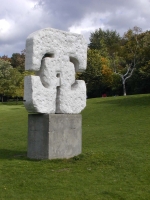Pierre Székely
L'ange de pierre
1964
Presentation of the artwork
L’ange de pierre is a monolithic white-marble sculpture executed by Pierre Székely for Mount Royal Park. Its simple, unadorned form leaves visible the rectangular shape of the block of stone from which it was carved, and its main faces have two different textures. On one side, the traces of the artist’s chisel are manifested in a very rough relief. On the other side, a smoother surface highlights the block’s abstract silhouette. On both lateral surfaces of the artwork, rounded geometric forms are carved into the stone.The artwork is extremely evocative. Whereas its title encourages us to see in the volume the simplified figure of an angel, such as one that we create by lying down in the snow and moving our arms and legs, its simplicity also evokes a sort of imaginary letter, a schematic grapheme belonging to an unknown civilization.
This rounded three-dimensional shape with a rectilinear depth is reminiscent of the curved lines that dominated Székely’s pieces during the 1960s, found notably in his walk-in sculptures such as La cité des jeux in L’Haÿ-les-Roses (1958) and his architectural work Village de vacances Renouveau in Beg Meil, Brittany (1964–66).
Associated events
Székely’s artwork was executed for the International Sculpture Symposium in Montréal (1964), the first time a symposium was held in North America. The goals of this concept, created a few years earlier in Europe, were to have artists create monumental sculptures in a context of encounters with the public and to provide public spaces with international-calibre artworks. Instigated by sculptor Robert Roussil, this symposium gathered 11 sculptors from nine countries and attracted more than 40,000 visitors. It was seen as one of the events that brought Québec into artistic and cultural modernity.
Pierre Székely
Pierre Székely (Budapest 1923–Paris 2001) studied drawing and printmaking in schools and studios in Budapest. He discovered sculpting in stone in a labour camp during the war, and he produced his first architectural sculptures when he arrived in France in 1946.
Over the years, Székely’s playground sculptures for children and his technique of shaping granite with flame made him very famous. His artworks are found today, among other places, in Pécs, Hungary, where an outdoor museum is devoted to him.
Over the years, Székely’s playground sculptures for children and his technique of shaping granite with flame made him very famous. His artworks are found today, among other places, in Pécs, Hungary, where an outdoor museum is devoted to him.
Awards and honours
- Docteur Honoris Causa, Académie Royale des Beaux Arts de La Haye, Pays-Bas, 1978
- Grand Prix, Biennale Internationale des Arts de la Rue, 1978
Presentation of the artwork
L’ange de pierre is a monolithic white-marble sculpture executed by Pierre Székely for Mount Royal Park. Its simple, unadorned form leaves visible the rectangular shape of the block of stone from which it was carved, and its main faces have two different textures. On one side, the traces of the artist’s chisel are manifested in a very rough relief. On the other side, a smoother surface highlights the block’s abstract silhouette. On both lateral surfaces of the artwork, rounded geometric forms are carved into the stone.The artwork is extremely evocative. Whereas its title encourages us to see in the volume the simplified figure of an angel, such as one that we create by lying down in the snow and moving our arms and legs, its simplicity also evokes a sort of imaginary letter, a schematic grapheme belonging to an unknown civilization.
This rounded three-dimensional shape with a rectilinear depth is reminiscent of the curved lines that dominated Székely’s pieces during the 1960s, found notably in his walk-in sculptures such as La cité des jeux in L’Haÿ-les-Roses (1958) and his architectural work Village de vacances Renouveau in Beg Meil, Brittany (1964–66).
Associated events
Székely’s artwork was executed for the International Sculpture Symposium in Montréal (1964), the first time a symposium was held in North America. The goals of this concept, created a few years earlier in Europe, were to have artists create monumental sculptures in a context of encounters with the public and to provide public spaces with international-calibre artworks. Instigated by sculptor Robert Roussil, this symposium gathered 11 sculptors from nine countries and attracted more than 40,000 visitors. It was seen as one of the events that brought Québec into artistic and cultural modernity.
Pierre Székely
Pierre Székely (Budapest 1923–Paris 2001) studied drawing and printmaking in schools and studios in Budapest. He discovered sculpting in stone in a labour camp during the war, and he produced his first architectural sculptures when he arrived in France in 1946.
Over the years, Székely’s playground sculptures for children and his technique of shaping granite with flame made him very famous. His artworks are found today, among other places, in Pécs, Hungary, where an outdoor museum is devoted to him.
Over the years, Székely’s playground sculptures for children and his technique of shaping granite with flame made him very famous. His artworks are found today, among other places, in Pécs, Hungary, where an outdoor museum is devoted to him.
Awards and honours
- Docteur Honoris Causa, Académie Royale des Beaux Arts de La Haye, Pays-Bas, 1978
- Grand Prix, Biennale Internationale des Arts de la Rue, 1978





